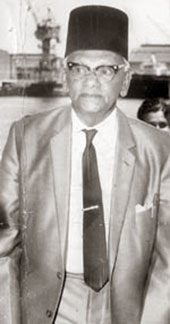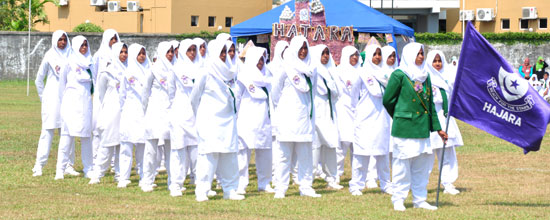|
Opening up new vistas for Sri Lankan Muslim women:
The saga of Ayesha Rauf
by B.C. Sharma
 |
|
Ayesha Rauf |
Today, Sri Lankan Muslim women are in the forefront in acquiring a
modern education, especially English education, as seen in the
mushrooming of "International Schools" run by Muslim institutions, which
teach through the English medium.
Young Muslim women are now excelling in IT, Accountancy, Business
Administration, academia and journalism, where they undertake the
toughest assignments without making a fuss.
But only five or six decades ago, Sri Lankan Muslim women were a
different group - conservative and restricted to the four walls of their
houses, with little or no contact with the world outside. For the
patriarchs of the community, female education, especially a modern
secular education, was anathema. In fact, a non- religious education was
considered unnecessary even for the Muslim male who was mostly in retail
and wholesale trade.
However, in line with the awakening among the Sinhalese Buddhists and
Hindu Tamils in the last two decades of the 19th Century, leading lights
of the Muslim community in Sri Lanka, like Siddhi Lebbe (1838-1898), A.
M. Wappachi Marikkar (1868-1925) and I. L. M. Abdul Azeez (1867-1915),
prodded by the Egyptian émigré, Orabi Pasha, started the island's first
English medium school for boys-the Madrasathul Khariyathul Islamiah in
1884.
But due to poor response from the community, the school was soon
abandoned.
It took another six years for it to reappear as the Colombo Zahira
College, which is alive and kicking to this day.
Close on the heels of the establishment of Zahira College came the
first school for Muslim girls, the Anglo-Mohammadan Girls' School in
Kandy in 1892, set up by Lady Havelock, the wife of the then Governor of
Ceylon. Soon, schools for Muslim girls cropped up in Galle, Matara and
Kurunegala, but only to vanish quickly for want of the Muslim
community's patronage.
 |
|
Sir Razik Fareed -archives.dailynews.lk |
In her well-researched monograph on Ayesha Rauf, who made a seminal
contribution to Muslim girls' education in the post independence era,
sociologist Farzana Haniffa points out that the lack of patronage was
marked in urban areas like Colombo.
Woefully illiterate
She quotes an 1892 Administrative Report to say that the experimental
school set up at Vauxall Street, Colombo, had closed, for want of
students. A. R. Abdul Rahman, a Muslim member of the Legislative Council
wrote that it was "very difficult" to make Muslim girls "swallow the
sweats of social education either at the secluded schools or at the
public schools." He went on to ask if Muslims would be interested in
female education when they were not even interested in male education.
Placing all this in the educational context at the close of the 19th
Century, Farzana says that in 1891, the female literacy rate was
generally dismal, being three percent for Sinhalese women and 1.7
percent for Muslim women. There was some progress in the first two
decades of the 20 Century with a Muslim girls' school being opened even
in Addalachenai in the backward Eastern Province.
But still, the Muslims were lagging far behind the other religious
communities.
There was a fresh awakening among the Muslims in the 1930s when C. W.
W. Kannangara was giving a tremendous thrust to education in the island
as the Education Minister in the State Council.
But as before, a person from another Muslim country had to trigger
the change among Muslims here.
If in the late 19th Century, it was an Egyptian, Orabi Pasha, who
urged Sri Lankan Muslims to go for an English education, in the 20th
Century, it was a visiting Turkish lady doctor, Hayrunisa Atalullah, who
stressed the need for female education. "It is only by uplifting the
woman that you can uplift the man," Dr. Hayrunisa told The Times of
Ceylon.
However, it was not until 1941 that first Muslim Ladies College was
opened. But this institution, set up by the Ceylon Moor Ladies'
Association at Colpetty, had to close down due to the war.
Enter Ayesha Rauf
The end of the war coupled with the entry of a new personality from
South India completely changed the course of female Muslim education in
the island. Ayesha Rauf, a Madras University graduate from Malabar in
Kerala, rekindled interest in female education in her adopted country -
Sri Lanka.
Unlike her predecessors, Ayesha saw to it, through tireless labour
and inexhaustible zeal, that Muslim schools did not close down for want
of patronage by the Muslim community. She found that Muslim institutions
were not starved of funds, but lacked community support and
participation.
 |
|
Students of Muslim Ladies
College -
sri lankan muslims.lk |
With the patronage of Sir Razik Fareed, Ayesha set up the Muslim
Ladies College (MLC) in Bambalapitiya, Colombo, in September 1946, on
land donated by Sir Razik. MLC is today a premier girls' school in
Colombo, serving not just the elite but the Muslim hoi polloi in a
unique experiment in social integration.
"Ayesha Rauf was a pusher. She would go from house to house urging
families to send their girls to the school. Her involvement in Colombo
Municipal politics (she was a Deputy Mayor at one time) gave her access
to a cross section of Muslims. She utilized this not only for garnering
votes but to get students for her school, which gave free education with
a government grant," said Anberiya Haniffa who was a student of MLC
between 1962 and 1968.
Ayesha's tireless house-to-house advocacy sent up enrolment from 20
to 200 in two months. Researcher Farzana notes that Ayesha's concern for
the maintenance of Islamic culture resulted in conservative parents
sending their girl children to the school without fear of alien
influences. Previously, parents withdrew the girl child from school, the
moment she attained puberty. Since food was another issue, Ayesha Rauf
saw to it that the school provided meals besides books (free of charge).
Despite Sir Razik's backing and government grants, MLC was woefully
short of funds due to an overall absence of interest in girls' education
among Colombo's Muslims. Since enthusiasm for female education was more
evident in the outlying towns than in the capital city of Colombo,
Ayesha wanted a hostel to be built so that outstation students could be
attracted.
According to Farzana, Ayesha herself used to stand at the Pettah
Railway Station with boys from the Moors' Islamic Cultural Home to
collect money by selling flags. Her efforts paid off. The hostel was
opened in the very second year of the school.
To make school life interesting while being 'functional' in a narrow
sense, Ayesha arranged for trips to various places, held parties, taught
the children to sing, act, sew and dress tastefully. Thus, Muslim girls
even from the less privileged classes emerged with social skills needed
to face the modern world.
Kerala's role
Since Ayesha's mission was to transform the cultural ethos of Sri
Lankan women without making them deviate from Islamic principles, she
did not impose an age bar on admission. In this sense, MLC was different
from other conventional schools.
If Ayesha was the agent of change in Sri Lanka of the 1940s and 50s,
it was because of her background. She came from Kerala, in South India,
a state which has had the highest rate of literacy in India since
colonial times. Though she belonged to the relatively uneducated
Mappilla Muslim community (an ethnic group of part Arab origin like the
Ceylon Moors, which was basically in trade), her family was forward
looking due to its involvement in Indian nationalist politics.
In her monograph on Ayesha, Farzana says her father, Vayaparathu
Kunath Mayen of Telicherry, was initially an activist of the Indian
National Congress.
Top freedom fighters like Gandhi, Nehru and the dynamic Sarojini
Naidu were introduced to Ayesha when they visited her hometown. Later,
Mayen became a Muslim Leaguer, which was fighting for Muslim rights in a
Hindu dominated polity.
Right from the beginning, Mayen wanted the Mappilla Muslims to be on
par with forward communities in Kerala like the Hindu Nayars and Syrian
Christians. He sent his two daughters not only to school but to the
university, disregarding the taunt that he had become a 'kafir' by doing
so.
Ayseha got a BA and a Licence in Teaching from Madras University. At
Queen Mary's College in Madras, she played tennis and took part in
English debating.
Having entered government service, she became an Inspector of
Schools, a job which required a lot of touring. Ayesha was not only the
first Mapilla Muslim graduate but also the first Muslim touring
Inspector of Schools in Kerala!
It was her marriage to Sri Lankan businessman M. S. M. Rauf in1943
which brought Ayesha to Sri Lanka. Rauf was running the Indian end of
his family's Colombo-based hardware business. He operated from
Coimbatore in Tamil Nadu.
According to Farzana, Rauf's wish to marry the highly educated and
forward looking Ayesha did not find favour with his family as he had not
gone beyond the Junior Cambridge level. But Rauf was undeterred. In
later years, he was to be a pillar of support for Ayesha's educational
and political ventures including her bold bid for a Parliament seat in
1947.
Why politics?
For Ayesha, social progress and political participation were
inseparable. Justifying her entry into politics even as she had taken up
the onerous task of setting up and running a pioneering English medium
school in an unfamiliar country, Ayesha wrote: "I knew that if women
were to achieve a fair deal and equal rights they needed women
representatives in Parliament to fight for them.
I also saw that Ceylonese women in general were politically backward
and that there were very few really interested in doing something for
their country by entering the political arena."
Her failure to make it to Parliament did not dampen Ayesha's interest
in pursuing politics as a vocation. She jumped into municipal politics
in Colombo and became the first Muslim woman Deputy Mayor in 1952.
She had an unbroken run in the Colombo Municipal Council till 1961
when she resigned to be a full-time educationist and Principal of MLC.
Till she retired in 1970, Ayesha saw to it that the MLC was an
instrument of social change among Muslims even as it catered to the
functional needs of students entering the job market. |

